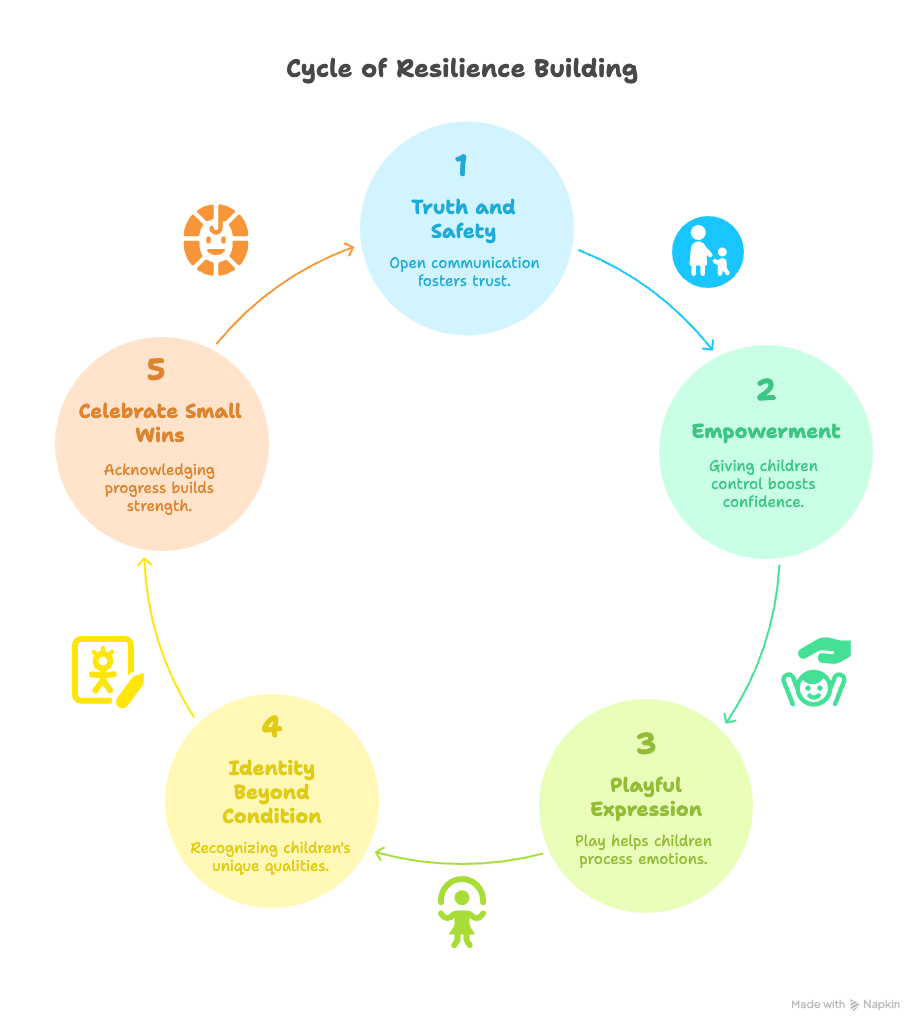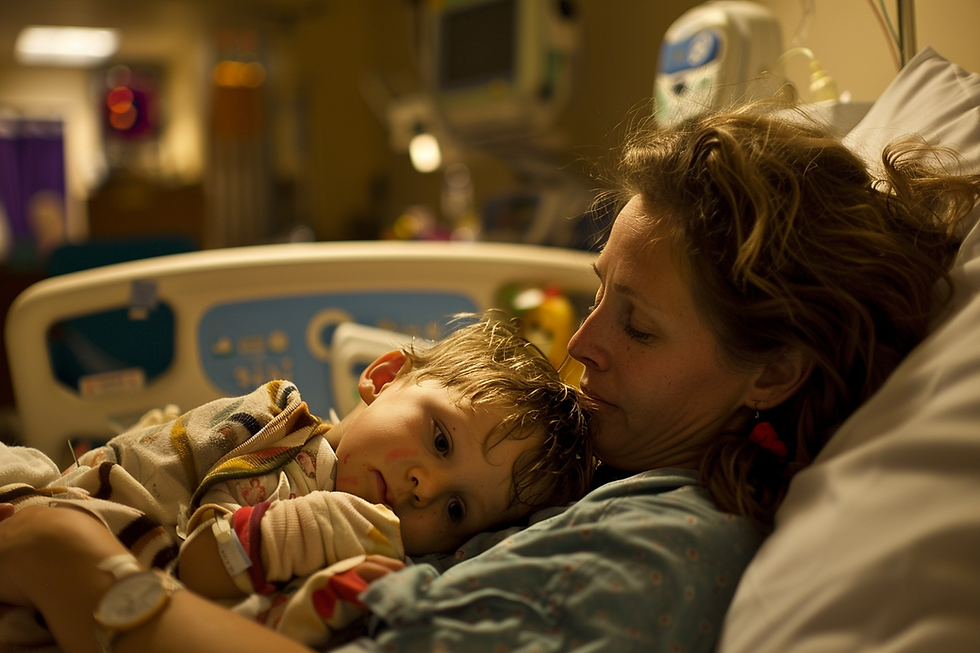Building Resilience in Children with Chronic Conditions
- Caroline Monteiro
- Jun 5
- 5 min read
How to help your child develop emotional strength for their ongoing medical journey.

I've had many patients over the years working in Paediatric Wards, but Lily always come to my memory.
She was seven. She had bright brown eyes, untamed curls, and a diagnosis that had brought her in and out of hospitals more times than I could count. Cystic fibrosis. Her lungs often betrayed her. The machines were her companions more than her schoolmates. The IV poles followed her like shadows. And yet… Lily smiled.
But not at first.
When I first met her, she was curled up in a corner of her hospital bed, refusing to speak. Her mother had stepped out to get tea. The room felt heavy. Monitors beeped. A drip clicked rhythmically behind us.
I sat beside her and asked, “Want to help me check your teddy’s lungs?”
I handed her a small stethoscope—just a toy from the play cart. She hesitated. Looked at me. Then at the bear.
Her tiny fingers touched the teddy’s chest, her brow furrowing in concentration. It lasted maybe thirty seconds.
Then she handed it back without a word and turned toward the window.
It wasn’t a breakthrough.It wasn’t magical.
But it was something.
It was the first time she engaged at all that day. The first time she reached toward something—even play—instead of pulling further inward.
And that’s how it usually goes.Resilience doesn’t come in grand, movie-worthy moments.It starts in quiet flickers. In a glance. In a sigh. In a game that doesn’t end in a tantrum.
We played again the next day. And the one after that. Sometimes she was into it. Sometimes she barely looked up.
But slowly, she began to talk. About how the teddy was scared. About how the teddy didn’t like the oxygen mask. About how the teddy needed someone to stay close.
She wasn’t just playing.
She was practicing.
Processing.
Learning that even when things felt out of control, she could still connect. She could still express. She could still matter.
That’s how resilience is built.Not through one powerful moment. But through many small, repeated ones.

Resilience Isn’t Magic. It’s Grown.
Parents often ask me, “How do I make my child more resilient?”
As if there’s a switch. But resilience doesn’t arrive like that. It’s not toughness or pretending not to care. It’s a set of experiences, gently repeated. It’s a belief that hard things can be faced—and survived—with love beside you.
And for kids with chronic conditions, resilience becomes the thing that carries them between appointments, tests, surgeries, and disappointments.
It’s not optional.It’s everything.
Step 1: Don’t Hide the Truth—Wrap It in Safety
When Lily first came into hospital, everyone tiptoed around her diagnosis. The grownups whispered. The nurses avoided details. Her parents said things like “We’re just here to help your cough.”
But she knew. Children always know.
So I sat with her and said:
“Your lungs need a little help. We’ll do some hard things here. But you get to ask any questions, and I’ll always tell you the truth.”
Her shoulders relaxed. She looked at me like, Finally.
We think we protect children with silence. But what we’re really doing is isolating them.
Resilience begins when the truth becomes speakable—and survivable.
Step 2: Let Them Be In Charge of Something
Hospital life is full of “no.” No food before surgery. No running in the hallway. No, we can’t skip the IV today.
But Lily taught me something important: kids need power to heal.
So we gave her choices. Simple ones.
Which hand for the pulse monitor?
Which cartoon during the nebulizer?
Which sticker after physio?
It changed everything. She started showing up—not just as a patient, but as a person.
Every child needs to feel that even in chaos, they still matter. Their voice matters. Their decisions matter.
Step 3: Invite Them to Play Out the Scary Parts
This is the part that feels magical—but it’s backed by science.
When I brought Lily a doll with an oxygen mask, she looked suspicious.
“What’s this for?” she asked.
I said, “This doll has lungs like yours. Want to help her feel brave?”
She looked at the mask, then slowly put it on the doll. “She doesn’t like it.”
“Yeah. That makes sense,” I replied.
And for the next ten minutes, Lily talked through the doll. What scared her. What helped. What she wished people said.
She found her voice in the space between pretend and real.
Play is the bridge between feelings and words. Between chaos and understanding.
And for children with chronic conditions, it becomes a vital path toward healing—not just physically, but emotionally.
Step 4: Show Them They Are More Than Their Condition
One day, Lily told me she was tired of being “the sick girl.”
So I asked her, “Who else are you?”
She thought for a while.
“I’m good at drawing. I like making people laugh. And I’m very fast at tying shoelaces.”
That’s the goal.
Resilience isn’t about being strong despite their condition. It’s knowing they are whole, rich, funny, talented people beyond it.
Build that story with them. Over and over again.
Step 5: Celebrate What They Do, Not Just What Gets Done
Progress in hospitals is usually measured by test results, oxygen levels, numbers.
But resilience lives in different places.
It’s when your child asks a question during the ward round.
When they say, “I’m scared” out loud instead of holding it in.
When they take one deep breath before the blood draw.
These are not small.
They are proof your child is building internal strength—one hard day at a time.

A Final Word (From One Nurse and Mother to Another Parent)
Lily didn’t become brave overnight. She cried. She refused treatment sometimes. She had days when the weight of it all felt too much.
But she also learned to laugh again. To say what she needed. To bounce back after a setback.
That’s resilience.
And your child is capable of it, too.
Not because they’re “extra special” or “born strong”—but because you’re showing up for them.Because you’re willing to meet them in their fear and walk them out of it.
If you’re reading this, you’re already doing the work.
Now let’s do it together—with less pressure, more play, and a whole lot of love.
Free Resource: Your Parent Resilience Toolkit
Want help getting started?
We’ve put together a free download to support you, including:
5 emotional scripts for medical conversations
A printable “Brave Chart” to track inner wins
Therapeutic play ideas for home or hospital
👇 Enter your email below to get the toolkit and build your child’s resilience—one moment at a time.
SEO Keywords: building resilience in children, chronic illness emotional support, pediatric resilience strategies, hospital anxiety in kids, medical play therapy, parenting children with chronic conditions



Comments